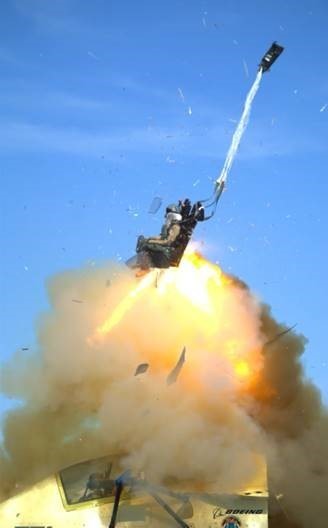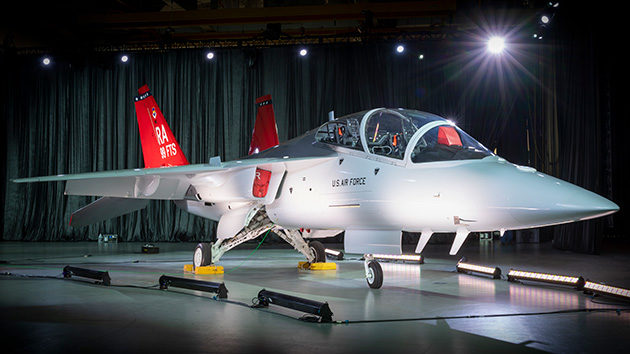Problems with the ejection seats in the Air Force’s new T-7A trainer jet are forcing the Air Force and its contractor, Boeing, to delay production deliveries until the second half of 2024.
Industry and Air Force officials have frequently lauded the Red Hawk for the use of digital design and engineering that allowed it to go from drawing board to first flight in 36 months, but the aircraft has encountered several setbacks in recent years that have pushed back the trainer’s initial, ambitious timeline.
This most recent hitch has been related to the jet’s “flight control software and the escape system,” an Air Force spokeswoman confirmed to Air & Space Forces Magazine. Air Force Times first reported on the issue.
“All flight control software issues to date have been resolved and will be tested in flight in the first quarter of 2023,” Air Force spokeswoman Maj. Alexandra Stormer said. “The Air Force is working to correct some escape system deficiencies found during initial testing in late 2021 and will resume escape system testing in the first quarter of 2023.”
The Air Force previously announced in October 2021 that it had started testing on the T-7’s ejection system, stating in a press release that it was using “the largest-class and smallest-class manikins” in tests given the broad range of body types the jet is being designed for.
A 2020 report from McClatchy pointed out that the Air Force previously designed aircraft based on the average measurements of pilots, in turn based on studies from the 1960s and 70s. That led to many women being automatically disqualified as pilots due to their size.
The T-7A is intended to be more accommodating of different body sizes, encompassing all pilots that can meet Air Force standards, which have been modified in recent years.

Ensuring the ejection system works for all those body types, however, has been a challenge. In its 2021 Weapon Systems Annual Assessment, the Government Accountability Office flagged qualification of the ejection system as one of two primary risks to the program’s schedule, and in the 2022 version of the report, the GAO once again noted the issue as a “top program risk.”
“If the program experiences delays in qualifying the emergency escape system, there is increased risk of delay to the November 2023 production decision,” the report states.
The Air Force is still aiming for that production decision, also called Milestone C, in November 2023, with a low-rate initial production contract coming a month later in December, Stormer told Air & Space Forces Magazine. But the actual delivery of production T-7s is now scheduled for the fourth quarter of fiscal 2024—ending Sept. 30, 2024.
That represents at least a year delay from the Air Force’s very earliest timelines for the program, but there have been other issues that have slowed the schedule as well. In 2021, the Air Force announced it had discovered an issue with “aircraft wing rock” in testing, meaning the T-7A could be unstable in the roll axis when flying at high angles of attack. That issue has subsequently been fixed, but supply chain issues have also created delays.
As a result, Boeing is now “working with the Air Force to re-baseline the schedule, including identifying opportunities to recover schedule after continued COVID-19 supply chain and workforce disruptions,” Boeing spokeswoman Mary Ann Brett told Air & Space Forces Magazine. “That said, the program is accomplishing new milestones as the pathfinder program for a digitally designed, built and tested system. … Boeing plans to complete all supporting activities by [the third quarter of] 2024.”
The third quarter of calendar year 2024 coincides with the fourth quarter of the fiscal year, matching up the Air Force and Boeing’s timelines.
Boeing acknowledged issues with “pre-flight testing and hardware qualification, but have a good path to resolution in place to work through these,” Brett added.
And despite the delays in the program, both the Air Force and Boeing remained firm that they will continue to use the digital design and simulation process that built the T-7 for other programs moving forward.
“Working from our digital design, build and test programs for the T-7A Red Hawk, we went from firm concept to first flight on our two production-relevant jets in just 36 months,” Brett said. “Following this digital path has enabled us to make early discovery of anomalies, in some cases, years before the first aircrew ever step into the advanced trainer.”
“We are committed to continuing use of digital design on our future programs using model-based systems engineering and 3D design tools,” Stormer added.
Boeing officially rolled out the production version of the T-7A this past April, but while the service waits for the new jet, it continues to rely on the aging T-38 Talon to train its future fighter pilots. The T-38 has had a string of mishaps lately, including two last month and 10 Class A or B mishaps in the previous four years.
